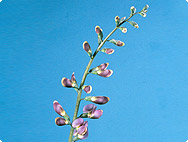A.Vogel search
When the internal search is activated, personal data such as your IP address is transmitted to our search engine Cludo. Data is thus transferred to a third country. Please click here if you want to display the internal search. You can find more information on data protection here: Privacy policy.
Baptisia tinctoria (L.)
Wild Indigo
History

The genus name Baptisia is derived from the Greek báptisis, which means ‘immersion‘, and baptízein, báptein, which translates as ’to immerse, baptise, soak, dye‘. Tinctórius means ’of dyeing’, from the Latin tingere for ‘to dye‘. These names all refer to the indigo-like (blue) pigment obtained from the leaves.
Botanical characteristics
The short root stock is almost woody. The exterior is grey-brown; the interior is yellowish and filled with numerous light coloured fibres. The very branchy, yellow-green, finely-grooved stalk grows up to 1 metre high and is covered with triplets of blue-green, alternate, short-stemmed leaves and small, thorny secondary leaflets. The terminal, yellow papillionaceous flowers form loose clusters. The fruit is a 2cm to 3cm long, greatly distended, blue-black pod with a leathery shell and almost kidney-shaped, knobbly seeds.The Wild Indigo flowers from July to August.
Habitat
The Wild Indigo is native to southern Canada and the eastern and north-eastern United States. It is frequently found on dry, sandy to clayey soils and sparse deciduous and conifer forests, deforested areas and roadsides. Cultivations in Central Europe thrive.
Preparation
A.Vogel/Bioforce uses a homoeopathic mother tincture produced in accordance with the current Homöopathisches Arzneibuch (HAB) (New Official German Homoeopathic Pharmacopoeia) from the fresh, underground parts of the plant. Potentisation of the dilutions is carried out manually.Tinctures and extracts are also produced from the root. In Canada and the United States, the young shoots are eaten like asparagus.
A.Vogel Blog – Natural and Healthy
Inspiration for a healthy life!



